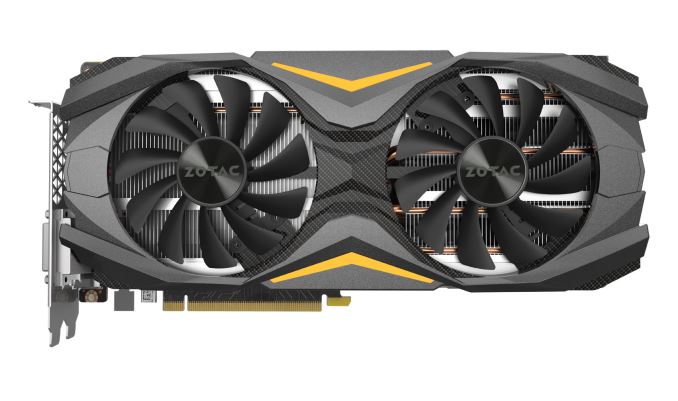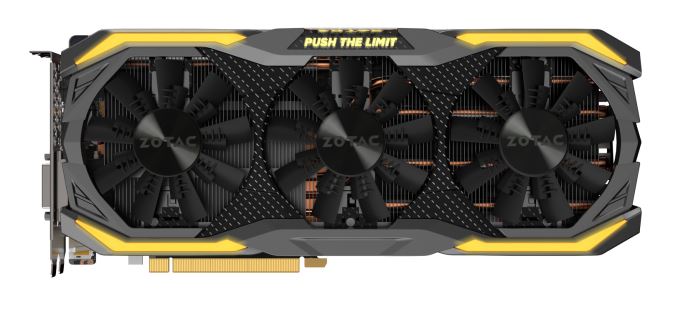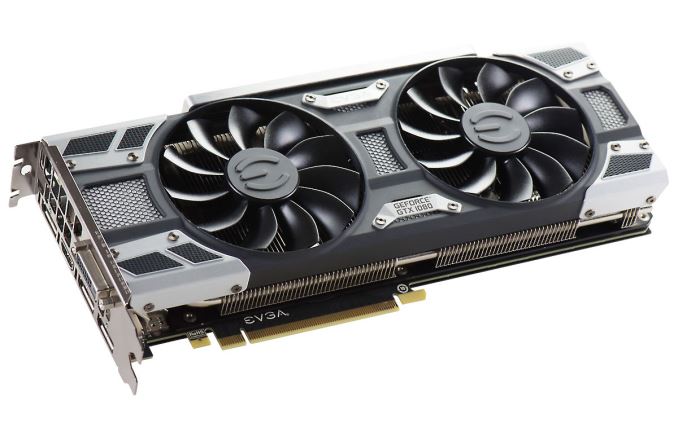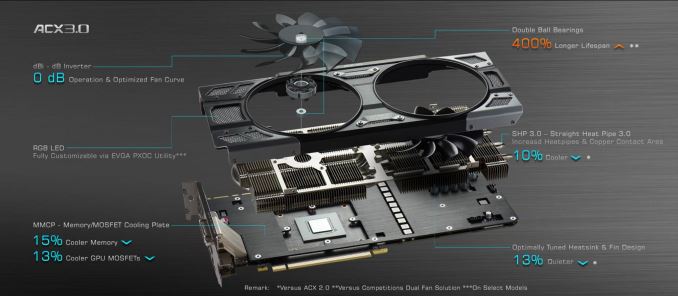Zotac and EVGA Reveal Custom GeForce GTX 1080 Designs
by Daniel Williams on May 27, 2016 9:00 AM EST
A few weeks back we saw the announcement of NVIDIA’s GeForce GTX 1080. NVIDIA put the founders cards on sale first, with third-party cards set to be released later. As we approach the sale date of the 1080 we can now lift the covers on the solutions other vendors will be releasing. Today features cards from both Zotac and EVGA.
Zotac will be releasing two custom version of the GeForce GTX 1080, the GeForce GTX 1080 Amp Edition and Amp Extreme. Both cards will receive their own revision of their Icestorm cooler. The key differences between the two for the cooler is that the the AMP Edition (pictured above) sports five heatpipes and two 100mm fans, while the AMP Extreme will have six heatpipes, three 90mm fans, and those fans will have a new design aimed at reducing the dead spot in the middle of the fan. Zotac claims that on the latter this will increase airflow and reduce noise.
Speaking of noise, both cards will have a 0 dB fan idle mode that they call Freeze, which stops the fan under low load situations. Each of these cards will be wearing what Zotac calls “Carbon Exoarmor”. Featuring a full backplate, a metal fan shroud, and what appears to be carbon fiber highlights.
To aid with fitting these cards in with any build these cards will feature Zotac’s all new Spectra lighting system. Meaning that these cards will have RGB LED’s on both the front and back of the card, and will be fully adjustable from the redesigned FireStorm App. Pricing and availability for these cards is not yet known.
EVGA’s entry into the ring is the EVGA GeForce GTX 1080 SC Gaming ACX 3.0. What this will mean is a card that carries the third iteration of their ACX 3.0 Cooler Featuring a 0 dB fan idle mode, RGB lighting, and a load of heatsink changes. EVGA is specific on two features of this cooler including their Straight Heat Pipe 3.0 technology which they say increase heat pipe and copper contact to increase cooling. They also note a cooling plate, a.k.a. heat spreader, that sits between the PCB and the heatsink to cool memory and MOSFETs.
| GTX 1080 Specification Comparison | ||||||
| EVGA GTX 1080 SC Gaming |
GTX 1080 Founders Edition |
|||||
| Core Clock | 1708MHz | 1607MHz | ||||
| Boost Clock | 1847MHz | 1733MHz | ||||
| Memory Clock | 10Gbps GDDR5X | 10Gbps GDDR5X | ||||
| VRAM | 8GB | 8GB | ||||
| TDP | 180W | 180W | ||||
| Launch Date | Early June | 5/27/2016 | ||||
| Launch Price | MSRP: $649.99 | MSRP: $699 | ||||
Worth noting for these numbers is increased base and boost clocks to the tune of about 6%. A moderate but practical difference. Aside from that we are looking at the standard memory and memory speeds. EVGA will also be releasing Precision X 6.0 to Coincide with the upcoming release. The EVGA GeForce GTX 1080 SC Gaming ACX 3.0 card will release in early June for $649.99.
As the incoming hardware approaches we can look forward to learning more of what the market will bring us. Today saw the announcement of cards from Zotac and EVGA, though I’m sure we’re bound to see many more releases as summer comes upon us. Be sure to keep an eye out here in the coming weeks as review samples start to trickle in.













39 Comments
View All Comments
ghanz - Friday, May 27, 2016 - link
An extra "1" on the EVGA GTX 1080 boost clock. 11847MHz Boost clock is possible another 2 decades perhaps :).HollyDOL - Friday, May 27, 2016 - link
Hehe, I wouldn't mind such model :-) But that's clearly subconscious wishful thinking at work here... both on my side and the author's...nathanddrews - Friday, May 27, 2016 - link
Why is the model with higher base and boost clock (assuming 1847MHz) selling for $50 less?Also, glad to see some 1080 cards that might actually hold an OC longer than 10 minutes.
nathanddrews - Friday, May 27, 2016 - link
Nevermind, I thought that was a comparison of EVGA vs Zotac. Haha, the FE is such a scam.Monkfishy - Friday, May 27, 2016 - link
Nvidia has an "early adopters" tax on its reference "founders" edition GTX 1080. Never ever buy reference cards. They are overpriced, have bad cooling solutions and are more expensive than Aftermarket cards from MSi, Gigabyte, Zotac, EVGA etc...Samus - Friday, May 27, 2016 - link
Umm, reference cards have arguably the best cooling solutions from a reliability standpoint. They are designed to go into an OEM chassis and work for years without any maintenance. They also work in any chassis from SFX/ITX to large workstations because cooling volume inside the case is unimportant.AnnonymousCoward - Sunday, May 29, 2016 - link
Not from a noise standpoint.Samus - Sunday, May 29, 2016 - link
Most gamers fall into two categories: headphones or loud speakers.Noise is irrelevant. These are not the GTX 580 days. Most modern cards, presumably these (since the 970/980 were partially passive cooled) don't even run the fan at idle, and if they do, it's virtually silent. And in a game, the volume of the game will mask it. My PNY 970 blower can not be heard during hours of gaming, even mildly overclocked, in a tiny FT03-mini case.
Top down coolers just don't make sense. It's fine for a CPU to exhaust the heat into the chassis, but triple the heat? Gaming GPU's are 140-180 watts and gaming CPU's are ~60 watts.
ognacy - Monday, May 30, 2016 - link
"Noise is irrelevant"Not for those that do content creation and play games on the same rig (like myself). I want this stuff quiet under full load for hours. And, fortunately, the market is full of quiet and fast CPUs and GPUs. I am currently using a Xeon E5-1660-v3 at 4.2GHz, on air, that's 8 cores, 2x nvidia 970 in a quiet case with a few Noctua fans - and I honestly can barely hear it under full load, and it's certainly not loud. To me, and I am sure many others, noise level is key when choosing.
Impulses - Tuesday, May 31, 2016 - link
Same here, I have a case with plenty of airflow so I don't mind more efficient top-down coolers one bit. I'm probably going with dual 1070 to replace my 2x R9 290'